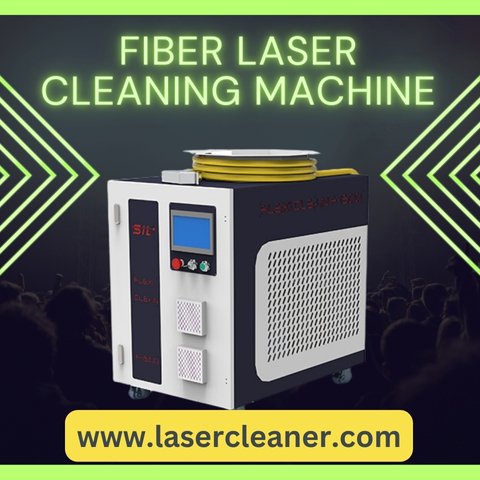When you walk into a metal fabrication shop, aerospace facility, or automotive manufacturing plant today, there’s a noticeable shift happening — but it’s not loudly broadcasted. Instead, industries are quietly but firmly pivoting toward a powerful piece of technology: the fiber laser cleaning machine. This isn’t just a minor change in process; it’s a full-scale evolution in how surface preparation, paint removal, rust stripping, and degreasing are done. But what’s behind this shift, and why are so many organizations making the change discreetly?
To understand this movement, you must first understand what the fiber laser cleaning machine really is — and how it’s shaking up every industry from shipbuilding to electronics.
What Exactly Is a Fiber Laser Cleaning Machine?
A fiber laser cleaning machine uses a highly concentrated beam of laser light to clean surfaces at the microscopic level. It operates without chemical solvents, abrasives, or water. The laser pulses rapidly, vaporizing layers of contaminants like rust, paint, grease, or oxide without damaging the base material. The process is dry, contactless, and highly precise — a trifecta of modern industrial needs.
What separates a fiber laser from other types of lasers is the fiber optic delivery system, which provides extreme beam stability, flexibility, and a longer lifespan. The energy is delivered with pinpoint accuracy, and the cleaning process is both efficient and incredibly repeatable — which matters in industries where precision isn’t just appreciated, but required.
The Quiet Revolution in Industrial Cleaning
The question isn’t just about what this machine can do, but why industries are choosing it over decades-old methods like sandblasting, chemical etching, or ultrasonic baths. The answer lies in a mix of strategic foresight, environmental regulation pressure, labor safety concerns, and cost-over-time calculations.
1. Environmental Pressure and Regulations
Governments around the world are tightening environmental regulations. Chemicals used in paint removers, acids for descaling, or solvents for degreasing often produce hazardous waste. Disposal is expensive and regulation-heavy.
Fiber laser cleaning machines sidestep this altogether. They produce no secondary waste, no chemical runoff, and no toxic fumes that require elaborate ventilation systems. For organizations looking to meet ISO 14001 compliance or reduce their carbon footprint, it’s a silent but strong solution.
2. Labor and Workplace Safety
Ask any operator who has worked with chemical baths or abrasive blasting equipment. It’s messy, dangerous, and often requires full-body protection gear. The health risks range from skin burns to long-term respiratory damage.
With fiber laser cleaning, the operator uses a handheld or robotic-assisted nozzle that never touches the surface. There’s no kickback, no toxic inhalation, and minimal noise. As safety boards worldwide enforce stricter workplace conditions, companies are preemptively upgrading to fiber laser systems to stay compliant — and protect their workforce.
3. Cost Control Through Longevity and Precision
While traditional methods may appear cheaper on paper, they often carry hidden costs: frequent material wear, high labor intensity, chemical purchase and disposal, and machine downtime due to part replacements.
Fiber laser cleaning machines bring long-term predictability to operational budgets. The non-contact approach reduces wear on tools and treated surfaces. The laser source itself can last over 100,000 hours of operation, requiring minimal maintenance. For CFOs and operations managers, that kind of performance stability becomes impossible to ignore.
Use Cases That Explain the Quiet Shift
To fully grasp the disruptive nature of this technology, consider how different sectors are implementing it:
Aerospace
Aluminum and titanium parts in aircraft require exact surface preparation before coating or bonding. One micron too much, and the part becomes compromised. Fiber laser cleaning ensures uniformity — without introducing micro-scratches or embedding grit, as abrasive methods do.
Automotive
Automotive manufacturers use the machines for mold cleaning, rust removal from chassis components, and pre-welding surface prep. With automation integration, laser systems are mounted on robotic arms for inline cleaning — boosting productivity without increasing labor.
Oil & Gas
Pipelines and offshore rigs corrode fast. Maintenance teams are adopting fiber laser systems to clean metal surfaces before applying anti-corrosion coatings. Since no chemicals are involved, cleaning can be done even in sensitive marine zones.
Heritage Restoration
Old churches, statues, and monuments are being restored without abrasive brushing or chemical peeling. Fiber lasers selectively remove pollutants and surface grime without damaging underlying stone, wood, or metal.
Behind Closed Doors: Why the Shift Isn’t Broadcasted
So why the secrecy? Why aren’t companies bragging about their shift to fiber laser cleaning?
In competitive industries, the smallest technological edge can make a huge difference in production quality, turnaround time, or regulatory compliance. Businesses treat their adoption of efficient, low-maintenance tools as intellectual property. It’s not about hiding — it’s about protecting strategic investments.
Also, in many cases, the replacement is phased quietly. A workshop retires one sandblasting cabinet and installs a fiber laser station. It becomes the new normal without fanfare.
Buying Trends: Who’s Leading the Adoption?
Countries with strong manufacturing sectors — Germany, China, the USA, Japan — are leading the charge. In Europe, stricter environmental norms are pushing medium and large enterprises to invest in fiber laser technology. In Asia, the drive comes from automation and speed. In North America, it’s about safety and precision.
SMEs (small and medium enterprises) are catching on too. As prices drop and compact models enter the market, laser cleaning becomes feasible not just for Boeing, but for your local welding shop, mold shop, or railcar refurbisher.
Future Integration: What Comes Next?
Fiber laser cleaning machines are increasingly being integrated into Industry 4.0 environments. This means smart sensors, remote diagnostics, and integration with PLCs (programmable logic controllers). Machines can now:
-
Detect surface contamination levels in real-time
-
Adjust laser power autonomously
-
Generate operation logs for quality control
We’re entering an era where machines don’t just follow instructions — they make micro-decisions to maintain performance quality.
Final Thoughts
The fiber laser cleaning machine isn’t just an innovation; it’s a transformation. It is altering how industries approach cleanliness, efficiency, and safety. The shift is strategic, quiet, and irreversible. Companies that adopt this technology early position themselves for cleaner operations, safer workplaces, and long-term cost savings.
While the spotlight may still shine on more glamorous tech — AI, robotics, and big data — it’s these behind-the-scenes tools that are redefining industrial reality. If your business touches metal, paint, grease, or corrosion, and you’re not yet exploring fiber laser cleaning machines — you’re already behind.







